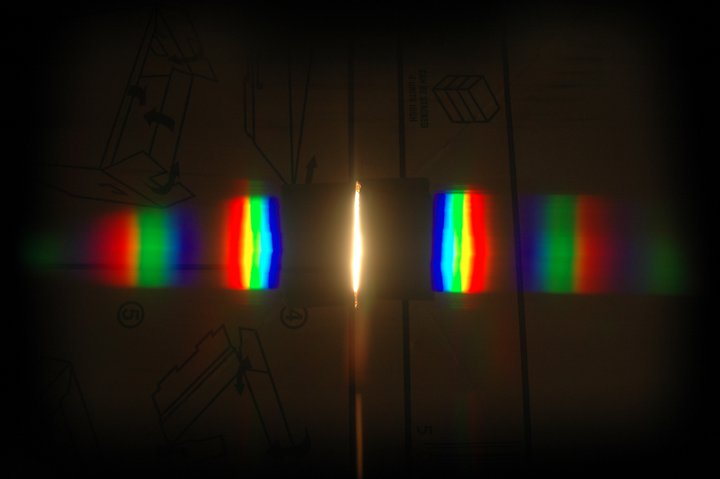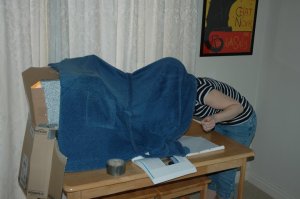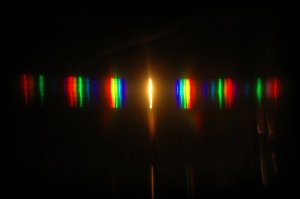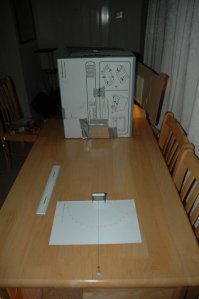I have had a lovely weekend in the sunshine, much of which has been spent outside in our garden, under the beautiful cherry tree, on our new garden furniture. I've been pottering around, weeding the vegetables, planting more seeds, and watching the cats chase motes of dust.
In between, I've been studying hard - book 3, Energy and Light. I'm almost there; I've completed most of TMA03; all I needed to do was Activity 11.1 - Investigating Light.
Joe and I liberated a cardboard document box from his offices, and I planned my experiment. It is set out below, just as it is in my folder (with perhaps just one or two embellishments, and an extra instructive illustration). Some of the details have been changed and the first-person voice has been used because the write up was part of the assessment, and so cannot be made public for fear someone may plagiarise me. So some of this may or may not be true!
Investigating light: determining the wavelengths of spectral lines from an energy-saving light bulb.
Equipment
- Diffraction grating (300 lines per mm)
- Tungsten filament light bulb (40 W)
- Energy-saving light bulb (11 W)
- Lovely stripy table lamp (for the tungsten bulb)
- Tall standard lamp (for the energy-saving bulb)
- Large cardboard document box
- Pieces of Amazon book cardboard
- Gaffer tape
- Sharp knife
- Paper protractor
- Blu-Tack
- Black cotton thread
- Red drawing pin
- Dressmaker's pin
- Eye-patch
- Table
- Dressing gown
Aim
To determine the wavelengths of blue, green and red spectral lines from an energy-saving light bulb.
Method
Having liberated the box from Joe's work in a ninja-style midnight operation, I cut a thin slit in it using the sharp knife. Joe took this off me, and did it properly with a minimum of blood spilled. I tidied the edges using gaffer tape. Gaffer tape can do anything: FACT. The table lamp containing the tungsten bulb was placed within, and Amazon cardboard was cobbled around the edges, in an attempt to prevent too much light from escaping and having a party where my spectral lines were supposed to be.
I had a gander through the diffraction grating, and this is what I saw - a continuous spectrum:
Next, I needed to take a look at the spectrum produced by the energy-saving bulb. So I undid my gaffer-taped masterpiece, and fumbled the floor lamp with the energy-saving bulb under there. I couldn't quite manage to see the spectrum this time, so I created a dark-room, thus:
This created the ideal conditions to observe and photograph my diffraction spectrum - which was not continuous, and was in fact a line spectrum. Again, I photographed it:
All this was very pretty, but had to be interrupted by a trip to Charlie's to make me a longbow. You see, my marvellous husband (he of the fabulous presents) bought me A Big Piece of Wood for my birthday. Not just any piece of wood, mind; a piece of yew, laminated with maple and lemon wood. He, Charlie and I began the shaping of a (very) long bow. It's going to be grand!
Back to science.
Later, when darkness had fallen, I continued my experiment and set up my equipment. Leaving the box with the energy-saving bulb where it was, I stuck it down to prevent any disastrous movement, and placed a paper protractor about 50cm away. A drawing pin pierced the protractor, to provide an anchor point for the thread. The diffraction grating was placed upon the protractor at the axis. Thread was tied to the drawing pin and the dressmaker's pin, and all was ready. See:
This is where the eye-patch comes in. To measure the angle of diffraction for each spectral line, you have to line up the spectral line itself with the line on the grating and the thread upon the protractor. This is to be done with one eye, to prevent parallax error. I found myself unable to do this, and so had to use an eye patch.
Of course, it naturally followed that I had to conduct the rest of the experiment in the manner of a pirate. Grog was acquired, and duly consumed. Tables were swabbed, angles were swashed, and the thread was buckled. Much like my knees.
The experiment was a success! The wavelength of the blue, green and red spectral lines from the energy-saving light bulb were calculated as: 450 nm, 550 nm and 600 nm respectively. This isn't far off the actual wavelengths of light emitted by an energy-saving light bulb. Go and google it if you don't believe me.
This has been Science, by Vicky. I've enjoyed it; all that remains to be seen is how well my tutor likes the write-up... I do think that the eye patch was relevant. And the dressing gown.



